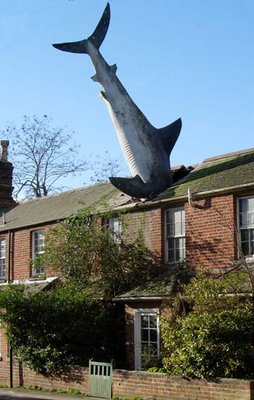This week’s Friday Funny is another one from the “you have to see it to believe it” file. The world of weird architecture is officially just a little bit weirder. Yes folks, there is a house in Oxford, England, with the back half of a shark protruding through its roof.
Here’s the explanation (complete story found at this link)…
This ordinary home became the centre of world attention, and the headless shark still excites interest today.
Bill Heine commissioned the shark and still owns the house. An American who studied law at Balliol College, he was running two Oxford cinemas at the time, but since 1988 he has been better known as a Radio Oxford presenter. When pressed by journalists to provide a rationale for the shark, he suggested the following:
‘The shark was to express someone feeling totally impotent and ripping a hole in their roof out of a sense of impotence and anger and desperation…. It is saying something about CND, nuclear power, Chernobyl and Nagasaki.’
The headless sculpture, with the label “Untitled 1986” fixed to the gate to the house, was erected on the 41st anniversary of the dropping of the atomic bomb on Nagasaki. Created by the sculptor John Buckley, it is made of fibreglass, weighs four hundredweight, and is 25 feet long.
Now this is where it gets interesting (and you thought you had strange zoning requests)…
Oxford City Council tried to get rid of the shark on the grounds that it was dangerous to the public, but engineers inspected the roof girders that had been specially installed to support it and pronounced the erection safe. The council then decided that the shark was development within the definition contained in Section 22 of the Town and Country Planning Act 1971, and that as such it had to be removed. Their offer to display it in a public building such as a swimming pool was not, however, accepted by Bill.
Bill played for time, but in 1990 he was refused retrospective planning permission by Oxford City Council. Undeterred, in 1991 he appealed to the Secretary of State for the Environment (then Michael Heseltine); and in 1992 Heseltine’s Inspector Peter Macdonald came out in favour of the applicant, and had the following to say about the shark:
‘It is not in dispute that this is a large and prominent feature. That was the intention, but the intention of the appellant and the artist is not an issue as far as planning permission is concerned. The case should be decided on its planning merits, not by resorting to ‘utilitarianism’, in the sense of the greatest good to the greatest number. And it is necessary to consider the relationship between the shark and its setting …. In this case it is not in dispute that the shark is not in harmony with its surroundings, but then it is not intended to be in harmony with them. The basic facts are there for almost all to see. Into this archetypal urban setting crashes (almost literally) the shark. The contrast is deliberate … and, in this sense, the work is quite specific to its setting. As a ‘work of art’ the sculpture (‘Untitled 1986’) would be ‘read’ quite differently in, say, an art gallery or on another site. An incongruous object can become accepted as a landmark after a time, becoming well known, even well loved in the process. Something of this sort seems to have happened, for many people, to the so-called ‘Oxford shark’. The Council is understandably concerned about precedent here. The first concern is simple: proliferation with sharks (and Heaven knows what else) crashing through roofs all over the City. This fear is exaggerated. In the five years since the shark was erected, no other examples have occurred. Only very recently has there been a proposal for twin baby sharks in the Iffley Road. But any system of control must make some small place for the dynamic, the unexpected, the downright quirky. I therefore recommend that the Headington shark be allowed to remain.’
And so it has survived. No one living in Headington notices it much any more, but it caused a tremendous stir both locally and nationally on the day it appeared. It had been winched up by a crane overnight, and although the police were aware of what was going on they were powerless to do anything, as there is no law to prevent a man from putting a shark on his own roof.



















![[VIDEO] Collect Asset Data at the Speed of Walking a Building](https://facilityexecutive.com/wp-content/uploads/2024/02/maxresdefault-324x160.jpg)